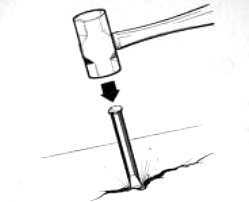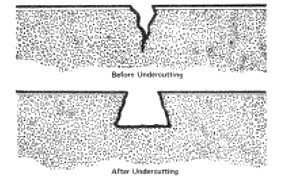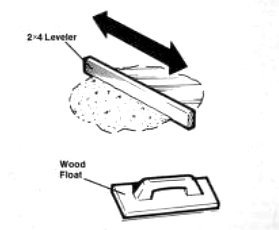Cracks and holes in concrete should never be ignored, because temperature changes and water penetration, especially in cold weather, can very quickly break up the sound concrete around them.
To keep the damage from escalating, patch cracks and holes as soon as weather permits.
Supplies Used
Buy liquid concrete bonding agent and ready-mix sand concrete mix to repair the slab.
For large or deep cracks or holes, use gravel concrete mix.
Repairing Concrete Slab Cracks
Before a crack can be filled, it must be deepened and undercut so that the patch will bond properly.
Use a cold chisel and hammer to enlarge the crack and deepen it to a depth of one to two inches.
Wear safety goggles to protect your eyes as you work.
Angle the chisel into the crack to make the bottom of the opening wider than the top, this will lock the patch concrete into the gap.

Then remove all chunks of concrete, and brush the remaining debris out of the crack with a stiff broom or whisk broom.

Flush the cleaned crack thoroughly with a garden hose, turned on full-force, and then sponge out any standing water.
If the crack goes all the way through the slab, and ground underneath is eroded, pour sand into the crack just to the bottom edge of the slab.
Dampen the sand thoroughly with the hose.
While the crack is still wet, mix the concrete as directed.
A sturdy wheelbarrow is the most convenient container, use a shovel to mix the concrete.
When the concrete is mixed, pour liquid concrete bonding agent into the crack to coat the inside surface entirely.
Spread the bonding agent with a stiff paintbrush, and clean the paintbrush immediately when you finish.
Then quickly fill the crack with the wet concrete.
Pack the concrete in with a trowel, and make sure there are no air spaces along the bottom of the crack.
Smooth the concrete along the surface of the crack with the trowel.
If the crack is very wide, the surface of the patch should be leveled with the surrounding surface.
Set a piece of 2 x 4 on edge across one end of the crack, and pull the 2 x 4 in zigzags along the entire length of the crack.
This will level the patch and remove excess concrete.
Let the concrete set for about 45 minutes.
When the sheen of water has disappeared from the surface, smooth the concrete again with a steel finishing trowel or a clean piece of 2 x 4-a trowel will give the concrete a denser, more polished finish.
Then let the concrete cure for about a week.
During this time, spray the crack two or three times a day with the hose to keep the concrete from drying out too quickly.
If the crack is very wide, cover it with a sheet of plastic during the curing period. Lift the plastic two or three times a day to spray the crack.
Repairing Concrete Slab Holes
Before you can fill the hole, you must undercut it.
If it’s shallow, it must be deepened to at least one inch Remove all loose concrete.
Then, wearing safety goggles to protect your eyes deepen the hole with a cold chisel and hammer.
Cut all the way down to sound concrete, and angle the chisel out at the edges so that the bottom of the hole is wider than the top.
Remove the broken concrete and sweep out the debris with a stiff broom or whisk broom, then flush the hole thoroughly with a garden hose turned on full-force.
Sponge out any standing water left in the hole.
If the hole extends all the way through the slab, and the ground underneath is eroded, pour sand into the hole to the bottom edge of the slab, and moisten the sand thoroughly.
While the hole is still wet, mix the concrete in a wheelbarrow as directed.
Then quickly cover the inside surface of the hole with the concrete bonding agent.
Spread the bonding agent with a stiff paintbrush; pay particular attention to the undercut edges.
Clean the paintbrush immediately.
As soon as you’ve spread the bonding agent, shovel the new concrete into the hole; pack it into the undercut edges with a trowel.
Mound the concrete slightly above the surface of the slab, and then pound it down with the back of the shovel.
Cut through the concrete slightly above the surface of the slab, and then pound it down with the back of the shovel.
Cut through the concrete with the blade of the shovel to make sure there are no air spaces, and then pound the patch down again.
Leave the new concrete slightly higher than the surrounding surface.
Use a piece of 2 x 4 to level the patch.
You can do this by yourself if the patch is small, you’ll need a helper to level a large patch.

Set the 2 x 4 across the filled hole, and pull it in zigzags over the new concrete, the 2 x 4 will remove the excess and bring the concrete level with the surrounding surface.
The new concrete will have a sheen of water on the surface.
Let it set for about 45 minutes to an hour, and then, when the surface water has disappeared, smooth the concrete with a wood float until the surface is filmed with water again.
Use long smooth strokes and press lightly so you don’t mark the new concrete stop smoothing as soon as the water sheen reappears.
Let the concrete set again until the water sheen has disappeared.
If you want a rougher, nonskid texture, finish the surface of the patch with a push broom.
Set the broom on the old concrete to one side of the patch, and then push it slowly and evenly across the patch and onto the old concrete on the other side.
Don’t push the broom hard enough to dig into the concrete, what you want is an even brushed look.
After this final texturing, let the concrete cure for at least a week.
To keep it from drying out too quickly. cover the patch with a sheet of plastic.
Two or three times a day during the curing period, remove the plastic and spray the patch lightly with the hose.
